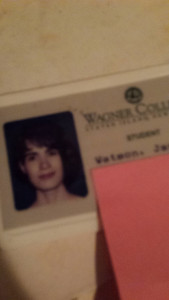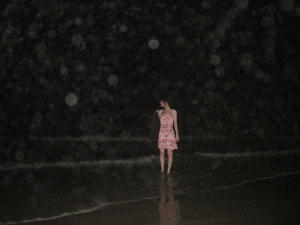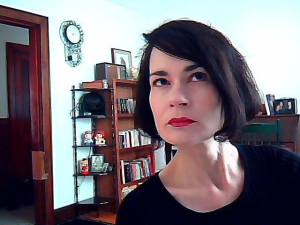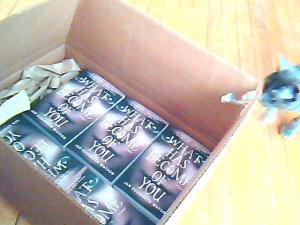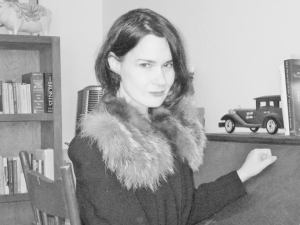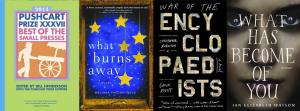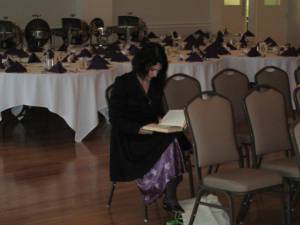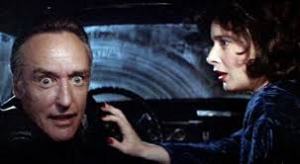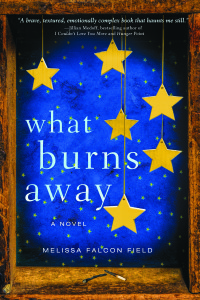
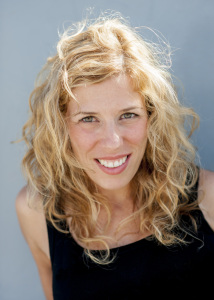
January 27th marks the publication release of a glorious debut novel, What Burns Away, by Melissa Falcon Field. It just so happens that Melissa is not only a formidable new talent on the literary fiction scene but is also my dear friend of more than twenty years and one of the best all-around human beings you could ever hope to meet. I was thrilled when Melissa generously agreed to answer a few interview questions about our early days, her personal writing process, and the path that What Burns Away took en route to publication and its imminent appearance in a bookstore near you—and in true Melissa Falcon Field fashion, she really gave it her all. Enjoy!
JW: You and I first met at the University of Maine at Farmington in the early to mid-1990s, where we were both majoring in Creative Writing. Amusingly, I have a clear memory of my first impression of you. You were this ebullient, energetic, and remarkably focused young woman in jean shorts, and I simultaneously was impressed by your apparent drive and certain that you wouldn’t want to be friends with the likes of me. I thought of Sylvia Plath in her Smith College years– so radiant and ambitious according to everyone who met her, yet deeply complex and blessed (or cursed?) with an enormity of feeling. When I first read your writing in Fiction Workshop, it both confirmed and refuted this impression. Your early writing had such a unique juxtaposition of sharpness and lushness that I still see in your work today. It was through writing, I think, that we formed our friendship– that, and due to your general kind nature. Do you have any particular standout memories or impressions of our early time at UMF and what we learned there?
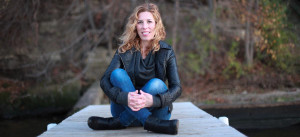
MFF: Jan, I love that you remember the jean shorts, stonewashed no doubt, given the era. And yes, there is so much I remember of that time and place where both of our writing lives, and our more than twenty-year friendship, began. If I have it right, you were in black combat boots and a purple shift, a black trench coat over top, walking beneath a black umbrella. On your shoulder you carried an enormous bag full of books, and with you, the air of something both sophisticated and girlish, both dark and illuminated, and immediately, captivated by you fashion and gothic tilt, I wanted to know you. What I remember most about our initial interaction was that it occurred in the basement of Mallet Hall, the dorm where we both lived, and you were heating up a Hot Pocket (dinner of novelists) in the microwave. While I stood there behind you waiting to warm up my coffee, you offered me bubble gum in a yellow wrapper. With me, I had my own gigantic bag of books, slung over my shoulder, ruining my posture, and you asked me what I was reading. I still remember that the book in my hand was a collection of Stepehen Crane stories, I was reading “Maggie a Girl of the Streets, and then I opened my canvas tote filled with others, Heart Songs by Annie Proulx, The Best American Essay collection that year, 1995, edited by Jane Smiley, and a few others I can’t quite remember. It was then, looking at my library books, that you asked me if I was a writer, a question to which I smiled and covered my mouth, a dream too big to admit to anyone. A few days later, to my great pleasure, I found you seated at the far end of the room, on the first day of my fiction writing workshop that term taught by the talented Pat O’Donnell, a life long mentor and friend to both of us, who lead us into deeper conversations after class ended about craft and character in our fiction. We carried those conversations out the door of the 209 B of Roberts Learning Center, to smoke cigarettes by the amphitheater, mulling over the stories we had read in class and talking about novel ideas of our own. Your plotlines—the one you fancied in those days, the ones you hoped to follow and write, were just as fearless and complex and unshakeable as your novels are today. I, too, see hints of your early work in both of your books, which I loved, Asta in the Wings, and What Has Become of You, which I stayed up all night to finish the day the galley arrived. In our early years writing together, we were so lucky not only to have found each other for what would become life-ling encouragement, but also to study with such talented professors, the Poet Laureate of Maine, Wes McNair, and our equally beloved professor of literature, Dr. Dan Gunn, who taught Shakespeare, in a classes where you spent some time crushing on a French exchange student, and where I met and fell madly for my college sweetheart. But my most constant memory of our time at the University of Maine at Farmington is of you and I sitting on “the beach” in the old student union, across from the radio station, both of us lost inside the works of the masters we wanted to emulate, for me—Eudora Welty, Raymond Carver, Willa Cather, Andre Dubus, Jane Smiley, Styart Dyebk, Mary Karr, Annie Dillard, and our own, beloved UMF professor, Bill Roorbach, who had just published his first memoir, a dream we could barely imagine for ourselves.
JW: Although many readers will be ‘meeting’ you with your debut What Burns Away, you have actually been a hardworking writer and a talent to contend with for many years now. What can you share about the novel’s journey toward publication and how it found its eventual home with Sourcebooks Landmark?
MFF: It’s true I have been writing ever since my undergraduate studies in at the University of Maine at Farmington, and throughout graduate school, where I earned my MFA at Texas State University. But my journey took a tegmental route, when after my time in Texas, I joined Teach For America to become an inner city schoolteacher and work hard for national school reform. Although I wrote in the stolen hours between teaching and night school, where I worked on a second Master’s Degree in Education, it wasn’t until I went back to teaching college-level classes, after nearly ten years in urban education, that I was able to have enough continuity in my writing life to work on long form narrative, successfully. It was at that time, when I had the luxury of carving out four full days a week to dedicate to reading and writing exclusively, every Tuesday, Thursday, Saturdays and Sunday, that I wrote a full manuscript and the first draft of What Burns Away, was born, a draft I would rework for four years, yes a long time, before I put it away for just over a year after the birth my son and during my husband’s and my decision to move to the Midwest. Shortly there after, once all our boxes were unpacked and my little boy began to toddle, I pulled out the manuscript and read every book I could that was written in a similar vein— Jillian Medoff’s work was huge influence at that time, and anything else tagged ‘domestic suspense’ by booksellers, and looked in the back to see who the book’s agents were in the acknowledgements. Then, I made a list of those agencies and agents, twenty in total, and sent out fifteen simultaneous, unsolicited query letters to those taking new clients. It took about six months for me to hear back from anyone, but then slowly requests for full manuscripts, and the rejections, came in. I ended up sending out ten full manuscripts of the novel in an earlier form. I got four rejections and six requests for phone calls. In the end, I had four offers for representation and I went with my beloved agent, Jennifer Gates at Zachary Schuster Harmsworth, because not only did she have the most enthusiasm for What Burns Away, but also she offered prescriptive ideas for revision before we sent it out, which was what I needed for my first book. Jen’s wisdom not only helped me make a more beautiful novel, but also led me to publishers who shared her same enthusiasm for What Burns Away. Shana Dhres, my wonderful editor, connected to Claire’s story and offered us a contract right out of the gate, and even before we entertained other phone calls, I knew the book would find its home with her at Sourcebooks, the largest woman-owned trade book publisher in the United States. It was all very exciting and I can’t begin to explain how grateful I am to these women, Jennifer and Shana, who helped make it all happen.
JW: The protagonist in What Burns Away bears a few superficial similarities to you: she is from New England and transplanted to the Midwest, for example, and she has a young son whom she adores. In many ways, however, she is completely unlike you. I was fascinated by your choice to make her a climatologist by profession, and I was additionally impressed by the way the themes and metaphors of climate and elements reverberate through the novel. What made you decide to make Claire a climatologist? Was there extensive research involved in this process, and if so, what was the most fascinating thing you learned?
MFF: My protagonist, Claire, as you have mentioned is both like and unlike me. At the time I was revising What Burns Away, I was a new mother myself, lost to a cross-country move with an ambitious husbanded who had his head buried in work. And in that period of time, I will admit, I had come undone a bit, no longer certain who I was, or who my husband and I were together. But Claire, as a fictional character, is a far more unhinged version of how I felt in those years and to complete the composite of her character, I did a ton of research. Some of what I studied was climatology, and astronomy, I also relied a bit on my own upbringing in that year of Halley’s comet, but the most extensive research I did was on fire science, on arson most especially. With the help of librarian Katherine Clark at the Sequoya Branch of the Madison Public Library here in Wisconsin, I retrieved and read all of Michael Faradays’ Lectures from his lecture series at the Royal Academy of London, The Chemical History of a Candle. I also preformed a few experiments of my own, lighting Ping-Pong balls on fire and making homemade flamethrowers out of aerosol cans in my very suburban backyard, to the great distress of my neighbors. I knew I had to study fire to understand Claire’s draw to it, so I could sense how that danger brewing inside of her. Also, as a writer, I needed to rationalize how that danger would manifest itself in woman with a solid grasp on chemistry, physics and weather patterns, the kinds of deliberations made by a climatologist. The who draw of Claire’s profession came from my personal obsessions with both the difference and commonalities between the two settings in the novel, one being Madison, Wisconsin, to where I had just then moved, and the other being the coast of Connecticut, where I grew up. Both settings desolation in winter, and their equally severe weather patterns, led to my choosing atmospheric science as Claire’s career choice, her knowledge of science and weather something that helped me inform her motivations as I further developed the novel’s plotlines.
JW: Without giving too much away, one of my favorite parts of your novel is when the reader gets to see a letter that a very young Claire Spruce had written to ‘Teacher in Space’ Christa McAuliffe. I also loved the epistolary sections of the novel where Claire is exchanging some pretty steamy and poignant messages with a pivotal character. As you were writing the novel– and again, without giving too much away– can you share what part of the process was most fun and delicious for you?
MFF: The sections of What Burns Away in which I write from the vantage point of Claire as a young girl and, in paticular that section in which she has written to ‘Teacher in Space’ Christa McAuliffe, are also among my favorites, Jan. Maybe because I still have all my letters from the students I taught over the years, which I thumbed through, searching out the right voice, for Claire, as a girl she once was—a girl with a very specific dream. And the incorporations of letters and emails within the book throughout are derived for my love for epistolary novels. There are so many I have enjoyed over the years, Memoirs of an Invisible Man, and the 18th century works of Samuel Richardson, Pamela and Clarissa, Jane Austen’s Lady Susan, and a lengthy contemporary list, such as The Perks of Being a Wallflower, The Color Purple, and Where’d You Go, Bernadette. What is exciting about the letters housed inside a novel, that story within the story, is the ways epistolary novels allow the reader access to intimacy through a private, often times secret, confession. In What Burns Away the acknowledgments Claire makes about the past, and her desires in the present is yes, steamy and poignant, but also serves as a means for readers to access her private truth, even we see her spending her days trying to push that truth, and all that haunts her, away. And it through those emails and letters that we learn the old, dangerous parts of Claire are still very much intact. For me writing those letters, both in terms of the tension and anticipation they build between Claire and the corresponded, was a wonderful exercise in thinking about the ways characters reveal themselves to each other in this world of social media, forcing me as a write to think the borderlines between the public and private landscape our characters occupy.
JW: As a writer, what is your greatest hope in terms of what you want your work to accomplish? If readers are discussing the work of Melissa Flacon Field 100 years from now, how would you like it to be remembered?
MFF: Like you, Jan, I have always loved coming of age novels, and for me, the onset of middle age is a kind of second coming of age. And therefore, I would like the work to be remembered for its work in capturing that moment when a woman realizes her youth is more behind her than it is in front of her, the ways this gives her pause, and all the ways she must decide what to let go of and what to hold close. The story is ultimately about identity; the ways characters in fiction redefine themselves, and in What Burns Away, it is “awakening” I am interested in as subject matter. There is something about redefining Claire inside her famil dynamicy, later professionally, and in terms of her sexuality throughout that fascinates me. What was once sexy, what once felt like desire, is driven by different external factors. There is also un-shrouding of former definitions of self and personal history that I hope people remember, because Claire coming of age something she can’t stop it, and it is simultaneously happening to every one around her, and so there is a redefinition of beauty, too, finding what is left underneath the obvious youthful pretty. I loved writing a character in this space, acknowledging these things about her. The process of that surrender for Claire is brutal and transformative and why I felt compelled to capture that moment in What Burns Away.
Thanks again, Melissa, for your inspiring thoughts. I hope you savor every second of the whirlwind that ensues with your book’s debut.
